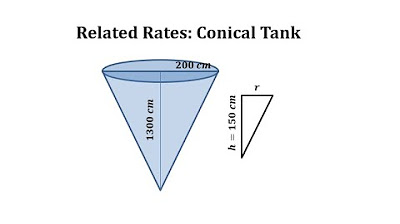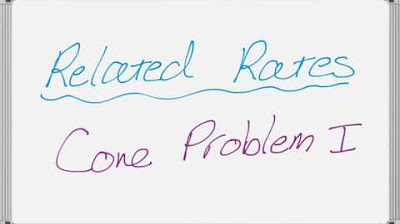Mixing Problems and Separable Differential Equations
TLDRThis video tutorial addresses mixing problems, often encountered in calculus or differential equations classes, by solving them using first-order separable differential equations. The example involves a tank with a brine solution where pure water enters and exits at a rate of 10 liters per minute, keeping the tank volume constant. The goal is to determine the amount of salt in the tank after a certain time. The video provides a step-by-step explanation, from setting up the problem to solving the differential equation and applying the initial condition to find the formula for the amount of salt remaining in the tank as time progresses.
Takeaways
- 🧪 The video discusses solving 'mixing problems' often encountered in calculus or differential equations classes using first-order separable differential equations.
- 🔍 The problem setup involves a tank with a certain amount of a substance (e.g., saltwater), where new substance enters and old substance exits at different rates and concentrations.
- 🌊 The example given has a tank with 1000 liters of brine containing 15 kilograms of dissolved salt, with pure water entering at a rate of 10 liters per minute, and the tank draining at the same rate.
- ⏱ The goal is to determine the amount of salt in the tank after a certain time T minutes, with the tank being kept thoroughly mixed.
- 📉 The change in the amount of salt with respect to time is calculated as the rate of salt in minus the rate of salt out, considering the concentrations and flow rates.
- 🔄 The differential equation is set up by considering the concentration of the incoming (pure water in this case, hence zero concentration) and outgoing mixture, which changes over time.
- ✍️ The differential equation derived is separable and involves integrating both sides after setting up the equation properly.
- 📈 An initial condition is provided: at time zero, there are 15 kg of dissolved salt in the tank, which is used to solve for the constant in the equation.
- 📚 The solution process involves taking the natural logarithm of both sides, integrating, and then exponentiating to solve for the amount of salt 'a' as a function of time 't'.
- 📉 The final formula for the amount of salt 'a' in the tank after time 't' is given by a = 15 * e^(-1/100t), indicating that the amount of salt decreases exponentially over time.
- 🤔 The video emphasizes the importance of correctly setting up the problem and understanding the rates of change as the challenging part of solving such problems.
Q & A
What are mixing problems in the context of calculus?
-Mixing problems in calculus typically involve scenarios where substances are being mixed or dissolved in a container, with inflow and outflow at different concentrations, and the goal is to determine the amount of a particular substance in the container after a certain time.
Why are first-order separable differential equations used to solve mixing problems?
-First-order separable differential equations are used because they can model the rate of change in the amount of a substance in the tank, which is often the difference between the inflow and outflow rates, making them suitable for solving mixing problems.
What is the initial condition of the tank in the given problem?
-The initial condition is that the tank contains 1,000 liters of brine with 15 kilograms of dissolved salt.
What is the rate of inflow and outflow of the tank in the problem?
-The rate of inflow and outflow is 10 liters per minute.
How does the concentration of salt in the tank change over time?
-The concentration of salt in the tank changes over time as pure water enters and the mixture, including the salt, exits at the same rate, diluting the salt concentration.
What is the differential equation derived to model the change in salt amount over time?
-The differential equation is dA/dt = -A/1000 * 10, where A is the amount of salt in the tank after T minutes.
How is the differential equation simplified in the problem?
-The differential equation is simplified to dA/dt = -A/100 by canceling out the common factor of 10 in the rate of inflow and outflow.
What is the method used to solve the separable differential equation in the script?
-The method used is separation of variables, followed by integration of both sides of the equation.
What initial condition is used to solve for the constant in the integrated equation?
-The initial condition used is A(0) = 15 kg, which is the amount of salt at time zero.
What is the final formula for the amount of salt in the tank after T minutes?
-The final formula is A = 15 * e^(-1/100 * T), which gives the amount of salt in the tank after T minutes.
Why is it important to consider the rate in minus the rate out when setting up the problem?
-It is important because the net change in the amount of a substance in the tank is determined by the difference between the inflow and outflow rates, which is the basis for setting up the differential equation.
Outlines
🧪 Introduction to Mixing Problems with Differential Equations
This paragraph introduces the concept of mixing problems, typically encountered in calculus or differential equations classes. The speaker outlines a scenario involving a tank with a specific amount of brine and salt concentration, where pure water enters and exits the tank at the same rate, maintaining a uniform mixture. The goal is to determine the amount of salt in the tank after a certain time, T minutes. The problem is set up as a first-order separable differential equation, which is a common method to solve such problems. The initial conditions and the process of setting up the equation are discussed, emphasizing the importance of understanding the rates of inflow and outflow and their impact on the concentration of salt.
📚 Deriving and Solving the Separable Differential Equation
The speaker continues by deriving the differential equation for the salt concentration in the tank over time. The change in salt amount with respect to time is expressed as the difference between the inflow and outflow rates, with the concentration of salt in the tank changing as the system evolves. The inflow is pure water with zero salt concentration, while the outflow's concentration depends on the current amount of salt and the tank's volume. The differential equation is simplified to a form that can be separated into variables and integrated. The integration process is explained, leading to the natural logarithm of the salt amount over time. An initial condition is applied to solve for the constant in the equation, resulting in a formula that describes how the amount of salt in the tank decreases exponentially over time.
🗣️ Conclusion and Invitation for Feedback
In the final paragraph, the speaker summarizes the process of solving the mixing problem and emphasizes the importance of setting up the problem correctly, as this is often the most challenging part. They highlight that once the problem is set up, solving separable differential equations typically involves natural logarithms and exponentiation, which are standard techniques in calculus. The speaker invites viewers to post comments or questions if they have any, encouraging further discussion and clarification on the topic.
Mindmap
Keywords
💡Mixing Problems
💡First Order Separable Differential Equations
💡Concentration
💡Rate In and Rate Out
💡Tank
💡Brine
💡Saltwater Mixture
💡Pure Water
💡Initial Condition
💡Natural Logarithm
💡Exponentiation
Highlights
The video discusses solving mixing problems using first order separable differential equations.
Mixing problems often involve a tank with an inflow and outflow of substances at different concentrations.
The goal is to determine the amount of a substance in the tank after a certain time, T minutes.
An example problem involves a tank with 1000 liters of brine containing 15 kg of dissolved salt.
Pure water enters the tank at a rate of 10 liters per minute, keeping the tank thoroughly mixed.
The tank's outflow rate matches the inflow rate, creating a closed system.
The change in the amount of salt with respect to time is the key to formulating the differential equation.
The rate of salt inflow is zero since pure water is entering the tank.
The rate of salt outflow depends on the concentration of salt in the tank at any given time.
The differential equation is set up as the rate in minus the rate out, leading to a separable equation.
The concentration of salt in the tank changes with time, affecting the outflow rate.
The differential equation is simplified to -a/100, where 'a' is the amount of salt in the tank.
The video demonstrates the process of separating variables and integrating both sides of the equation.
An initial condition is used to solve for the constant in the equation, given the salt amount at time zero.
The final formula for the amount of salt in the tank is derived as a function of time.
The video emphasizes the importance of setting up the problem correctly as the most challenging part.
The solution process involves natural logarithms and exponentiation, which are common in separable differential equations.
The video concludes by reiterating the importance of understanding the rate of change in mixing problems.
Transcripts
Browse More Related Video
5.0 / 5 (0 votes)
Thanks for rating:





